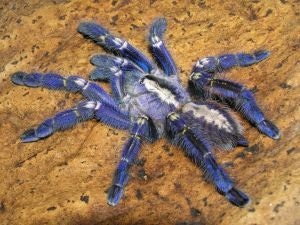Nov 18 2016
 The blue tarantula (Poecilotheria metallica) inspired researchers to produce non-iridescent structural colors. (Photo: Tom Patterson)
The blue tarantula (Poecilotheria metallica) inspired researchers to produce non-iridescent structural colors. (Photo: Tom Patterson)
Colors are created in various ways, and pigments are the best known colors. The feathers of peacock or the blue tarantula have very bright colors, but these are not caused by pigments, rather by nanostructures that cause the reflected light waves to overlap. This results in remarkably dynamic color effects.
Now, researchers from Karlsruhe Institute of Technology (KIT), in association with international colleagues, have succeeded in replicating nanostructures that produce the same bight color, independent of the viewing angle.
Structural colors are non-toxic, more vibrant, and durable, in contrast to pigments. However, in industrial production, these colors are strongly iridescent, meaning that the perceived color relies on the viewing angle. The rear side of a CD is one example of this phenomenon. Therefore, structural colors are not suitable for all applications.
Conversely, the bright colors of animals are usually independent of the viewing angle. Likewise, feathers of the kingfisher always seem to be blue, independent of the angle of view. This is attributed to nanostructures – irregular or amorphous structures always generate the same color, while regular structures are iridescent. However, in the industry, only regular nanostructures can be produced in a cost-effective way.
KIT researcher, Radwanul Hasan Siddique, in association with Belgium and USA researchers, has discovered that the blue tarantula, despite periodic structures on its hairs, does not have iridescence. The researchers initially showed that these hairs are flower-like, multi-layered structure and later examined its reflection behavior using computer simulations.
In parallel, the team used nano-3D printers to develop models of these structures and then optimized them with the aid of simulations. Finally, a flower-like structure was created that produces the same color over a 160 degrees viewing angle. So far, this is the largest viewing angle of any synthetic structural color to be ever reached.
In addition from the rotational symmetry and multi-layered structure, it is the hierarchical structure from micro to nano that guarantees the intensity of homogeneous reflection and prevents color changes.
The resulting color can be adjusted via the size of the “flower,” making this coloring technique interesting for the industry.
This could be a key first step towards a future where structural colorants replace the toxic pigments currently used in textile, packaging, and cosmetic industries.
Radwanul Hasan Siddique, Institute of Microstructure Technology, KIT
According to Dr. Hendrik Hölscher, scalability of nano-3D printing is the main challenge towards industrial use. At present, such prints are produced by only a few companies in the world, but Hölscher believes that going forward, this problem can be solved by rapid advancement in this field.
The study was partly funded by the common public. 3D printing costs were acquired through the experiment.com crowdfunding platform.